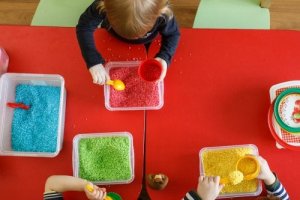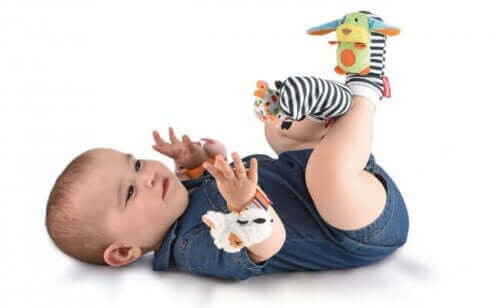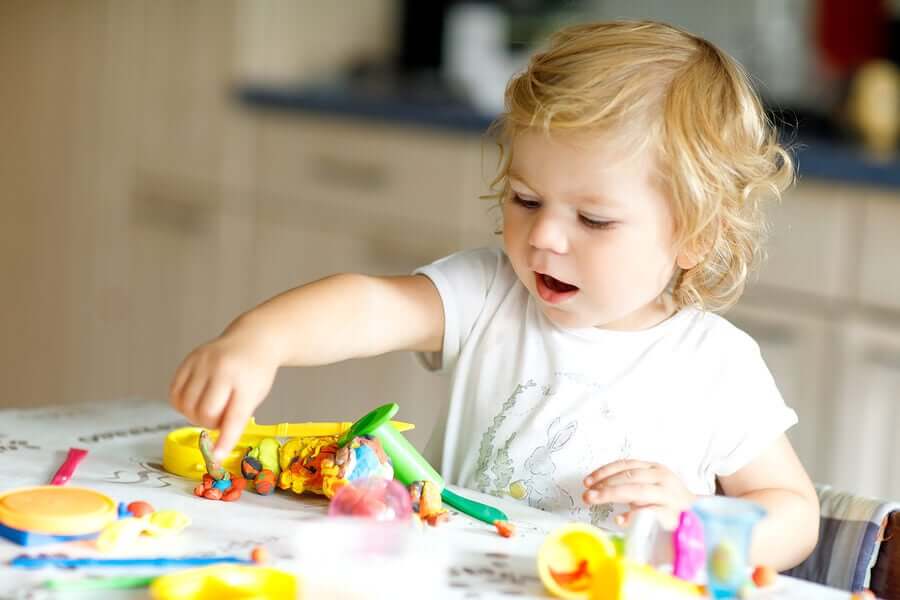Understanding Sensory Toys for Babies

Sensory toys for babies are important because they’re just beginning to develop their emotions. In newborns, emotions are scarce and weak during the first weeks of life. However, very soon, they’ll begin to display and experience a wider variety and gradually develop these new sensations.
The second month of life: Time to start sensory stimulation
In their first weeks of life, babies are capable of focusing their eyes on the human face. However, they aren’t able to do the same with inanimate objects, even when they’re very colorful.
It isn’t until the second month when little ones start to move their heads in the direction of noise. This is just the right time to start stimulating your child’s senses with sensory toys.
Sensory toys for babies play an important role, since they stimulate a baby’s senses: Sight, hearing, taste, smell and touch.

See also: Ways of Stimulating Your Baby’s Hearing
Babies have an innate curiosity. This drives them to explore and discover on their own, which allows their nervous systems to develop sensations and perceptions.
These sensations and perceptions that they capture during their first stage of life constitute very meaningful learning. They contribute to the development of basic cognitive functions, such as memory and attention.
Later on, as babies continue to develop, superior cognitive functions take place in their brains. These include, for example, creativity and language.
From then on, as a mother, you should incorporate sensory toys for babies into your little one’s routine. These will allow your little one’s sensory abilities to develop to their maximum potential. Furthermore, they also increase children’s cognitive intellect.
Discover: What Are the Basic Emotions in Children?
The benefits of sensory toys for babies
There are numerous benefits and advantages to using these kinds of toys. Below are just a few.
Sensory toys…
- Improve children’s ability to understand the world around them and to reason
- Stimulate creativity
- Increase abilities to build, even with elements that others have tossed out
- Increase the ability to concentrate
- Contribute to children’s independence, allowing them to have very personal points of view
- Keep boredom at bay
- Increase children’s ability to relate to other children
- Help children distinguish between colors, sizes and textures
- Are toys that encourage participation, cooperation and shared fun

Go deeper: How to Encourage Creativity in Children
Types of sensory toys for babies
Here we’ll offer several suggestions of sensory toys for babies that are ideal for early stimulation:
-
Sandbags
These are very easy to make at home. You can put together colorful cloth bags and fill them with beach sand or some other similar material. You can also mix things up by filling some bags with seeds, others with beans, etc. To finish off, just close up the seams and you’re all set!
-
Activity gyms
There are many different varieties of activity gyms available on the market, but you can also make your own. Start with a textured blanket and add an arch or bar over it where you can hang colorful objects. If the objects have sound, lights or smell, they’ll be even more attractive for little ones.
-
Slime
Here, all you need is a bit of water, cornstarch and food coloring. Mix all of the ingredients together and place them in a shallow container, like a dishpan or a baby bath tub. Don’t use too much water – the mixture should be thick and dense.
The resulting consistency will allow your baby to sink in his or her feet and hands and experience new sensations.
-
Activity blankets
Activity blankets are an ideal way for babies to construct and experience new sensations, either on their own or with your company. The thicker the blanket is, the more comfortable your baby will be as he or she explores.
-
Colorful spheres
Colorful spheres are very useful because of the diversity of learning and stimulation that they offer. They also have a therapeutic nature to them.
It’s important to point out that you should sanitize any sensory toy that your baby will play with beforehand. Little ones are prone to putting objects in their mouths.
The development of the five senses during the first stages of life is fundamental. Thanks to their senses, and their coming together with movement, children experience an assimilation process that makes way for the edification of learning. In this way, children begin to learn about the world around them.
Sensory toys for babies are important because they’re just beginning to develop their emotions. In newborns, emotions are scarce and weak during the first weeks of life. However, very soon, they’ll begin to display and experience a wider variety and gradually develop these new sensations.
The second month of life: Time to start sensory stimulation
In their first weeks of life, babies are capable of focusing their eyes on the human face. However, they aren’t able to do the same with inanimate objects, even when they’re very colorful.
It isn’t until the second month when little ones start to move their heads in the direction of noise. This is just the right time to start stimulating your child’s senses with sensory toys.
Sensory toys for babies play an important role, since they stimulate a baby’s senses: Sight, hearing, taste, smell and touch.

See also: Ways of Stimulating Your Baby’s Hearing
Babies have an innate curiosity. This drives them to explore and discover on their own, which allows their nervous systems to develop sensations and perceptions.
These sensations and perceptions that they capture during their first stage of life constitute very meaningful learning. They contribute to the development of basic cognitive functions, such as memory and attention.
Later on, as babies continue to develop, superior cognitive functions take place in their brains. These include, for example, creativity and language.
From then on, as a mother, you should incorporate sensory toys for babies into your little one’s routine. These will allow your little one’s sensory abilities to develop to their maximum potential. Furthermore, they also increase children’s cognitive intellect.
Discover: What Are the Basic Emotions in Children?
The benefits of sensory toys for babies
There are numerous benefits and advantages to using these kinds of toys. Below are just a few.
Sensory toys…
- Improve children’s ability to understand the world around them and to reason
- Stimulate creativity
- Increase abilities to build, even with elements that others have tossed out
- Increase the ability to concentrate
- Contribute to children’s independence, allowing them to have very personal points of view
- Keep boredom at bay
- Increase children’s ability to relate to other children
- Help children distinguish between colors, sizes and textures
- Are toys that encourage participation, cooperation and shared fun

Go deeper: How to Encourage Creativity in Children
Types of sensory toys for babies
Here we’ll offer several suggestions of sensory toys for babies that are ideal for early stimulation:
-
Sandbags
These are very easy to make at home. You can put together colorful cloth bags and fill them with beach sand or some other similar material. You can also mix things up by filling some bags with seeds, others with beans, etc. To finish off, just close up the seams and you’re all set!
-
Activity gyms
There are many different varieties of activity gyms available on the market, but you can also make your own. Start with a textured blanket and add an arch or bar over it where you can hang colorful objects. If the objects have sound, lights or smell, they’ll be even more attractive for little ones.
-
Slime
Here, all you need is a bit of water, cornstarch and food coloring. Mix all of the ingredients together and place them in a shallow container, like a dishpan or a baby bath tub. Don’t use too much water – the mixture should be thick and dense.
The resulting consistency will allow your baby to sink in his or her feet and hands and experience new sensations.
-
Activity blankets
Activity blankets are an ideal way for babies to construct and experience new sensations, either on their own or with your company. The thicker the blanket is, the more comfortable your baby will be as he or she explores.
-
Colorful spheres
Colorful spheres are very useful because of the diversity of learning and stimulation that they offer. They also have a therapeutic nature to them.
It’s important to point out that you should sanitize any sensory toy that your baby will play with beforehand. Little ones are prone to putting objects in their mouths.
The development of the five senses during the first stages of life is fundamental. Thanks to their senses, and their coming together with movement, children experience an assimilation process that makes way for the edification of learning. In this way, children begin to learn about the world around them.
All cited sources were thoroughly reviewed by our team to ensure their quality, reliability, currency, and validity. The bibliography of this article was considered reliable and of academic or scientific accuracy.
- Cabrera, M.C. y Sánchez C. (1982). La estimulación precoz; un enfoque práctico. Editorial Siglo XXI: España.
- Dorance, S. y Matter, P. (2001). Juegos de estimulación para los más pequeños. Madrid: AKAL.
- Flores, J. (2013). Efectividad del programa de estimulación temprana en el desarrollo psicomotor de niños de 0 a 3 años. Revista Ciencia y Tecnología, 9(4), 101-117. http://revistas.unitru.edu.pe/index.php/PGM/article/view/426
- Gallahue, D. (1982). Understanding motor development in children. New York: John Wiley and sons.
- Guerrero, A. M., & Primaria, I. Y. (n.d.). La estimulación temprana. https://archivos.csif.es/archivos/andalucia/ensenanza/revistas/csicsif/revista/pdf/Numero_14/AMALIA_MORENO_1.pdf
- González Zúñiga Godoy, C. I. (2007). Los programas de estimulación temprana desde la perspectiva del maestro. Liberabit, 13(13), 19-27. http://www.scielo.org.pe/scielo.php?pid=S1729-48272007000100003&script=sci_arttext&tlng=en
- Moreno, J. A. (1999). Motricidad infantil. Aprendizaje y desarrollo a través del juego. Murcia: Diego Marín.
- Moreno, J. A., & De Paula, L. (2006). Estimulación de los reflejos en el medio acuático. Revista Iberoamericana de Psicomotricidad y técnicas corporales, 6(2), 193-206. https://www.um.es/univefd/reflejos.pdf
- Ordoñez, M. y Tinajero, L. (2012). La importancia de la estimulación temprana en la etapa infantil. Madrid, 208-240.
This text is provided for informational purposes only and does not replace consultation with a professional. If in doubt, consult your specialist.








